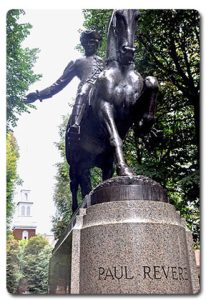A poet’s view of history …
April 18 1775
The Midnight Ride of Paul Revere, aka “Paul Revere’s Ride” is a most inspiring tale of a single brave man who rode a horse west into the Massachusetts countryside with a dire warning … “The British Are Coming! The British Are Coming!”

Unfortunately, the tale was not exactly an accurate accounting of the event in question.
Written in 1860 by Henry Wadsworth Longfellow, his poem tells the story of a guy who rides around yelling at anyone who will listen that British troops are heading their way!
It is most unfortunate Longfellow didn’t preface his poem with the now standard TV or movie disclaimer, “Based on, or Inspired by a True Story”
With several holes in the eyewitness account of Longfellow, the story doesn’t hold up in court!
First and foremost, Longfellow was not an eyewitness to the event. That would have been very difficult. Longfellow was not even born when Revere hopped on his horse and hightailed it toward Lexington and Concord. Henry was born on February 27, 1807 … Revere died on May 10, 1818, making young master Longfellow just 11 years old. As far as we know, they never met.
And his now famous poem? Longfellow’s pen never touched the paper until 85 years after the event. Although he probably knew the real story, his lack of on the ground research, a lot of poetic license, and a little patriotic finesse, the story became engrained onto the minds of school children and adults for years to come.
Unlike today, where every second the words spoken in public are recorded visually, or at least as audio … including “hot” mics (where someone gets caught with their knickers down by saying their real feelings out loud), that was not the case in the 18th century.
Take for example the following “Story”
George Washington threw a silver dollar across the Potomac River. Or maybe the Rappahannock River (which was less of a throw).
And the jeopardy answer is … “What never happened?”
As for the Silver Dollar thing …
A little geography: The Potomac River is about one mile wide near Mount Vernon – The Rappahannock River near Fredericksburg, Virginia … about 250 feet. As the latter was where George grew up as a child, the picture changes drastically. Not to mention, it was Martha Washington’s grandson, George Washington Parke Custis who came up with the story. And he was not even born until 1781, so certainly not a witness. There is no actual verification concerning either location.
A little numismatics: Silver dollars were not available during young, soon to be General George’s time. According to grandson George, it was actually a piece of slate … about the size of a silver dollar. An old piece of slate vs. a “silver” dollar. What sounds more inspiring to you?
And what about Patrick Henry’s, Give Me Liberty, or Give Me Death! speech at Saint John’s Episcopal Church in Richmond, Virginia, prior to the American Revolution.
And the jeopardy answer is … “What probably never happened?”
Relying on extremely old witnesses and probably a bit of Hollywood-like truth-stretching, the “author” of the supposed speech has become an unreliable narrator. There were no reporters, no outstretched arms holding microphones, no cameras. It would be a couple of centuries before social media would have held him accountable for his words!
It wasn’t until 1970 historians came to believe the substance of the speech that was “written down” 40 years later, might not have been exactly what was said that winter’s day on Church Hill in Richmond. Unfortunately, Patrick Henry was an orator who had quite a mouth on him. Fiery and boisterous, Patrick’s speech might have gone south quickly. What we do know, is that we don’t really know what was said, but probably not everyone in Saint John’s that day agreed with him.
They would become known as Tories!
Welcome to History 101!
Don’t always believe what you read. Research, research, research! You don’t get a Master’s Degree in History by putting your feet on the sofa, relying on hearsay, and then turning in your final paper.
A Little Truth Behind Paul Revere’s Ride
– Paul was not the only rider to head out west to warn whoever would listen.
There were at least three riders. Revere’s partner in crime (if they got caught) was William Dawes. Sometime later, Dr. Samuel Prescott joined them. Both Dawes and Prescott decided that sticking around after being stopped by British soldiers was not a solid move and disappeared into the night. Myths and legends about what happened to Dawes after his escape are just that! Fortunately, Prescott actually arrived in Concord early in the morning. He was able to get things moving, and the call went out for reinforcements. Approximately 400 men would rally at Concord Bridge to entice the British to return back to Boston.
– Paul never made it to Concord on a horse, or at all. He was forced to walk into Lexington (which is 7.1 miles east of the North Bridge at Concord)
During a detainment stop by the British along with Prescott and Dawes (who wisely hightailed it out of there), Revere was questioned, and relieved of his horse. Now on foot, he walked into Lexington to help Samuel Adams, and John Hancock do their own hightailing out of town to safety.
Whether Longfellow told the truth, a smattering of it, or even rearranged his “facts”. Whether Patrick Henry said the exact words that are attributed to him. Or whether Washington threw a Silver Dollar, or a frisbee across a river, is not important if you are just looking for a good story to read. And in the long run, is it even important to the average reader (although everyone deserves the truth)? With, or without, the actual stories, the outcome is still the same.
The colonists won the American Revolution …
… unless, of course, you were that overweight old codger, Benjamin Franklin, who discovered an alternate timeline where history didn’t turn out quite as he expected.
“Read All About It!” in the upcoming Franklin In Time series introduction

